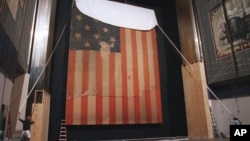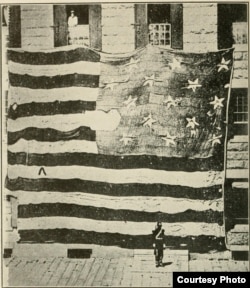This is a really big year at Fort McHenry, a star-shaped fortification overlooking the harbor in Baltimore, Maryland.
Baltimore and a few other places are commemorating the 200th anniversary of the start of what Americans call the War of 1812 - even though it wasn’t finished until 1815. Fort McHenry, and an oversized flag that flew above it, played a memorable part in that war.
What is sometimes called our nation’s “Second War of Independence” against Britain was not going well for the young United States when Fort McHenry came into play in September of 1814. The British had torched the White House and Capitol in Washington, and they headed north to Baltimore.
Their gunships pounded Fort McHenry mercilessly for 25 straight hours. If it fell, the harbor would be under British control, and so would Baltimore.
But at dawn, as Francis Scott Key, a Washington lawyer who observed the shelling, wrote in a poem, a miraculous visage of “broad stripes and bright stars” of the U.S. flag appeared, still “gallantly streaming” over Fort McHenry.
Thwarted and out of ammunition, the British sailed away and Key’s verses became the words to the U.S. national anthem, “The Star-Spangled Banner.”
As for the largest battle flag ever flown at the time, which Fort McHenry’s commandant, Lt. Col. George Armistead, had ordered raised as a defiant symbol of resistance: It survived, shot full of holes.
Col. Armistead kept it and allowed several pieces, including one of its 15 stars, to be snipped off and given away as souvenirs.
In 1912, what was left of the flag was presented to the Smithsonian Institution in Washington. After many restorations, it is front and center at the National Museum of American History.
And on Flag Day, June 14, this year, three red threads from the historic Fort McHenry flag were sewn into the “National 9/11” flag, a tattered remnant of an even more terrible attack on the United States by terrorists, who brought down the World Trade Center’s Twin Towers in New York on Sept. 11, 2001.
That 9/11 flag is currently on tour and will end up on display in the Sept. 11 Memorial that is being built at Ground Zero where the towers once stood.
The threads came from seven small patches of the original Fort McHenry flag that are held by the Star-Spangled Banner House Museum in Baltimore.
Baltimore and a few other places are commemorating the 200th anniversary of the start of what Americans call the War of 1812 - even though it wasn’t finished until 1815. Fort McHenry, and an oversized flag that flew above it, played a memorable part in that war.
What is sometimes called our nation’s “Second War of Independence” against Britain was not going well for the young United States when Fort McHenry came into play in September of 1814. The British had torched the White House and Capitol in Washington, and they headed north to Baltimore.
Their gunships pounded Fort McHenry mercilessly for 25 straight hours. If it fell, the harbor would be under British control, and so would Baltimore.
But at dawn, as Francis Scott Key, a Washington lawyer who observed the shelling, wrote in a poem, a miraculous visage of “broad stripes and bright stars” of the U.S. flag appeared, still “gallantly streaming” over Fort McHenry.
Thwarted and out of ammunition, the British sailed away and Key’s verses became the words to the U.S. national anthem, “The Star-Spangled Banner.”
As for the largest battle flag ever flown at the time, which Fort McHenry’s commandant, Lt. Col. George Armistead, had ordered raised as a defiant symbol of resistance: It survived, shot full of holes.
Col. Armistead kept it and allowed several pieces, including one of its 15 stars, to be snipped off and given away as souvenirs.
In 1912, what was left of the flag was presented to the Smithsonian Institution in Washington. After many restorations, it is front and center at the National Museum of American History.
And on Flag Day, June 14, this year, three red threads from the historic Fort McHenry flag were sewn into the “National 9/11” flag, a tattered remnant of an even more terrible attack on the United States by terrorists, who brought down the World Trade Center’s Twin Towers in New York on Sept. 11, 2001.
That 9/11 flag is currently on tour and will end up on display in the Sept. 11 Memorial that is being built at Ground Zero where the towers once stood.
The threads came from seven small patches of the original Fort McHenry flag that are held by the Star-Spangled Banner House Museum in Baltimore.








